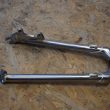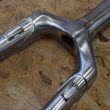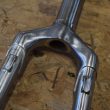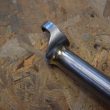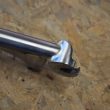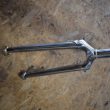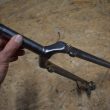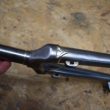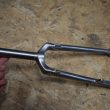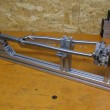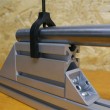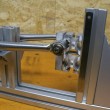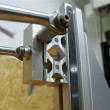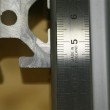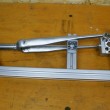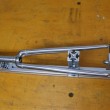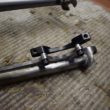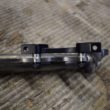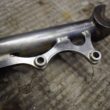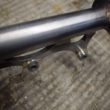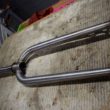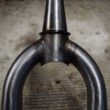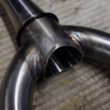1 inch, 10×100, E-Recumbent fork
![]() Sometimes, the only option is a custom solution for a particular situation. Below is a good example: a 1" fork for an E-Recumbent bike modification with a 250 motor front hub.
Sometimes, the only option is a custom solution for a particular situation. Below is a good example: a 1" fork for an E-Recumbent bike modification with a 250 motor front hub.
![]() Des fois le sur mesure est la seule option pour une solution a une situation particulière. Comme cette fourche 1" pour un vélo couché avec moteur de 250W dans le moyeu avant.
Des fois le sur mesure est la seule option pour une solution a une situation particulière. Comme cette fourche 1" pour un vélo couché avec moteur de 250W dans le moyeu avant.
Material: Steel
Steering tube: 1" threaded, length 140mm.
Fork length: ca. 290mm (for 20x1.5" / 37-406 tire)
Offset: 20mm
Dropouts: Ø10mm, 100mm spacing, deep and thick to take 250W motor torque
Brake mount: ISO Ø160mm
PS: Fork tubes have to remain outside dropout inner surface, to avoid interference with motor hub
Build your own fork jig
![]() Below is the recipe for building a fork jig out of Alu profile from that same Austrian supplier I mentioned already.
Below is the recipe for building a fork jig out of Alu profile from that same Austrian supplier I mentioned already.
![]() Voila une recette pour fabriquer un gabarit de fourche en profilés alu du même fournisseur Autrichien dont je parlais avant.
Voila une recette pour fabriquer un gabarit de fourche en profilés alu du même fournisseur Autrichien dont je parlais avant.
http://shop.aluprofil.com/de_FR/shop/Baureihe_8/Profile_8/
|
Total
|
Sub-total: | EUR 92,50 |
| + UPS Shipping (7 kg)*: | EUR 45,00 | |
| + VAT (20%): | EUR 27,50 | |
| Total: | EUR 165,00 |
Fork tricks
![]() When the ISO mount doesn't line up well with the fork blade (as is often the case with hooded dropouts), I use some rack eyelets as spacers to offset the ISO mount by a good 5mm and it lines up much better. The best is to braze the spacers in place, that way you can't lose them. Another useful thing to do is to miter the end of the steering tube to gain an extra 5 mm of tyre (and mud) clearance.
When the ISO mount doesn't line up well with the fork blade (as is often the case with hooded dropouts), I use some rack eyelets as spacers to offset the ISO mount by a good 5mm and it lines up much better. The best is to braze the spacers in place, that way you can't lose them. Another useful thing to do is to miter the end of the steering tube to gain an extra 5 mm of tyre (and mud) clearance.
![]() Quand la fixation disque ISO ne s'aligne pas bien avec le fourreau de fourche (souvent le cas avec des pattes coquilles), j'utilise des fixations de porte bagage comme des rondelles épaisses de 5mm pour décentrer la patte ISO et l'aligner mieux sur le fourreau. Le mieux c'est de les braser en place pour ne pas les perdre. Un autre truc utile c'est de passer un coup de scie cloche en bas du pivot de fourche, ca permet de gagner un gros 5mm pour le passage du pneu (et de la boue).
Quand la fixation disque ISO ne s'aligne pas bien avec le fourreau de fourche (souvent le cas avec des pattes coquilles), j'utilise des fixations de porte bagage comme des rondelles épaisses de 5mm pour décentrer la patte ISO et l'aligner mieux sur le fourreau. Le mieux c'est de les braser en place pour ne pas les perdre. Un autre truc utile c'est de passer un coup de scie cloche en bas du pivot de fourche, ca permet de gagner un gros 5mm pour le passage du pneu (et de la boue).

















